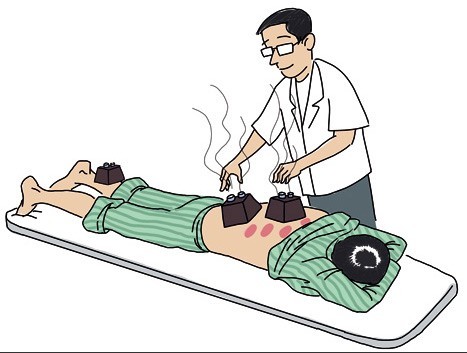| Home > China Feature |
TCM Magic
In martial arts there's often an unexpected master who produces an unlikely and obscure weapon just in the nick of time. That's not only true in kung fu but also in traditional Chinese medicine where little-known therapies have been developed outside the mainstream.
Herbal decoction, acupuncture, moxibustion, fire cupping and tuina (TCM massage) are well known in TCM and have developed over several thousand years. But
there are lesser-known treatments that also have been tested and proved effective through years of clinical practice, often by folk practitioners. Some are recent.
A number of interesting therapies and innovations were demonstrated earlier this month at a forum sponsored by the Shanghai Shuguang Traditional Chinese Medicine Research and Development Foundation.
Sixteen TCM practitioners presented treatments that have been tested over time in private or personal practice and experts believe they should be preserved and handed down.
The practitioners included certified TCM doctors, Western doctors interested in TCM, self-trained practitioners, "barefoot doctors" who received minimal basic medical training long ago in rural areas, and former patients who became experts after long illness.
The presentations included ancestral antiseptic ointment for burns, diagnosis by checking the palm print, tiny herbal plasters replacing ear acupuncture needles, convenient moxibustion box and tools, and a therapy of pounding acupuncture points with a herbal stick after spreading a herbal liquor on the affected area.
"TCM is not an art invented in schools, but it originated from inherited and collected experiences through thousands of clinical practices in the everyday world," says Zhu Kangmei, the president of the sponsoring TCM foundation.
Many non-mainstream therapies and techniques are effective but the demand for formal training and certification prevents many practitioners from legally offering treatment. And the unpromising future of unconventional therapies has forced many apprentices to leave for other, more widely recognized training.
"This is a crucial moment for us. Many of the techniques are dying out because they are not being handed down. The remaining practitioners, the inheritors, are already quite old and have no apprentices," says Zhu.
"It would be a great pity if these techniques were lost this way."
To save the dying therapies, the foundation started to collect effective TCM techniques from the public in 2009. More than 100 applications were submitted from around the country and 60-70 were selected for their value and apparent reliability. These were examined and more research and testing is needed.
Thus far, six practices or treatments have been singled out by a TCM expert panel as having the most development potential. They are: a convenient moxibustion box; a therapy of pounding acupuncture points with an herbal stick to relieve pain; massage to relieve inflammation in women's breasts; acupuncture with electric current to relieve the pain of herniated lumbar discs; painless ear acupuncture with herbal plaster; and festering or direct moxibustion that creates an infected blister to intensify heat on acupuncture points.
The foundation plans to arrange training in these techniques by folk practitioners for young TCM students and interested doctors. The aim is to preserve the techniques and give students and doctors more practical experience.
Moxibustion box

This is a small red sandalwood box with holes on four sides; it is heat and fire-proofed and contains a copper net layer to concentrate the infrared spectrum on the bottom of the box and spread the heat evenly. It also keeps ash from dropping on the skin. A spring adjusts the height of the burning moxa.
Since 2006 it has been used for 10,000-20,000 patients each year and about 1,000-2000 boxes are sold for DIY practices annually.
This is not a new therapy but a much improved tool. Traditional moxibustion involves burning moxa (usually an herbal stick) on or above acupuncture points.
With heat and moxa entering and traveling in the energy channels, it helps unblock energy channels, dispel so-called pathogenic energy and restore balance of
yin (cold energy) and yang (hot energy).
However, the venerable therapy has many practical problems, according to Dr Yu Ansheng.
"Most of the roughly produced moxa nowadays do not burn evenly and cannot provide constant heat and radiation. Embers and ash from the moxa stick may burn
the skin."
To improve the practice, Dr Yu collected moxibustion boxes used by lay practitioners, he improved the product and by 2006 had produced new boxes.
"The box has greatly improved the safety of moxibustion and it is much easier to practice - you don't have to find a very precise location since the box provides 6 square centimeters of radiation exposure," says Dr Yu.
Herbal stick pounding
Zhen ting, literally "shaking a stick," is an ancient therapy to relieve pain caused by trauma. It involves pounding the sore area with a small wooden stick.
Yu learned from Dr Wang Yuezhen of Shuguang Hospital and invented her own therapy for sore joints, tendons and muscles, combined with zhen ting, acupuncture,
moxibustion and fomentation (applying warm towels on the affected areas). She opened a clinic in 1986 and claims treatment is 97 percent effective in relieving pain, especially in the neck, shoulders, lower back and legs.
It also relieves pain of rheumatism and joint problems as well as aftermath of stroke.
It involves a small stick 40cm long and 2cm in diameter and herbal liquor that is crucial in the therapy since it enhances the effect of the stick's pounding to dispel pathogenic cold and improve blood and energy circulation.
Dr Yu learned the therapy in 1995 and opened her own clinic in 2007.
To make the liquor infusion she uses white spirit and she soaks 10 herbs in it for a month. They include chuan wu (monkshood), cao wu (radix aconiti agrestis), ru xiang (frankincense) and mo yao (myrrh).
First she uses acupuncture and moxibustion. Then she applies the liquor infusion to the affected area. She then uses the stick to pound (not hard) around 120
times a minute for 10-15 minutes on each painful area - until the area turns red and feels hot.
Then comes fomentation to strengthen the effect.
"Pain comes from blood and energy blockage so the affected area swells. Gently knocking the area and nearby energy channels can resolve stagnation and improve energy flow so pain and swelling gradually subside," says Dr Yu. The herbal liquor of yang, or warm herbs applied in advance enters the energy channels with the knocking and dispels pathogenic energies such as cold and damp.
For acute pain, two or three treatments are used; chronic pain requires long treatment, 10-20 sessions.
"Each therapy has advantages and disadvantages," says Dr Yu, "We found that the effect of stick pounding is multiplied with the alcohol infusion, acupuncture, moxibustion and fomentation."
Festering moxibustion therapy

Suppuration or festering cause by infection is usually a bad sign but not for retired TCM doctor Yan Hua. A sixth generation inheritor of her family's festering moxibustion therapy, Yan says numerous people have been cured or found relief when a festering sore is deliberately created by burning over an acupuncture point.
According to TCM, festering of the skin after burning moxa directly on the skin is a sign that moxibustion is taking effect.
Yan's family improved the moxa piles or cones placed on the skin by compressing them so they burn longer. Only about seven to nine pieces of moxa are needed,
compared with dozens in the old days. To accelerate the festering process and protect the wound from infection, the wound is sealed with an herbal plaster that creates humidity and raises the temperature.
A course of treatment involves three to five acupuncture points; one course a year is usually sufficient. July and August are the best months because the weather is already warm.
Yan says the treatment is especially effective in relieving chronic problems such as asthma, bronchitis and diarrhea.
Her reputation has been spread by word of mouth but Yan retired 20 years and doesn't have an inheritor to carry on. Her only apprentice left for overseas study when TCM was not popular, back in the early 90s.
"Festering moxibustion is much more difficult to master, compared with other methods and we didn't promote it over the years," says Yan. "But I hope the wisdom of our ancestor's doesn't disappear."
Ear acupuncture with herbal plaster
Ear acupuncture is widely accepted as an effective therapy but some people avoid it because they fear possible pain.
The pain problem was solved 20 years ago by an elderly self-taught practitioner - Wang Genfa.
Instead of sharp needles, he uses tiny square herbal plasters on acupuncture points in the ears, usually on the elevated areas.
He says it's as effective as needles to relieve problems such as high blood pressure, gallstones, enlarged prostate, symptoms of menopause, insomnia, constipation, diarrhea, abscessed finger and toenails.
The plasters are those commonly used on joints to relieve pain and inflammation, by unblocking energy channels and improving energy flow.
He uses common patent plasters.
They should not be placed on broken skin and should be used with caution for pregnant women, since some ingredients may cause miscarriage.
Trying to ease the pain of his father who had liver cancer in the 1970s, Wang read widely and practiced on his father.
Though it had no impact on the terminal cancer, it helped his father regain appetite and strength while he was undergoing chemotherapy and radiation therapy.
Wang offered free treatment to friends and neighbors who were delighted with results. His fame spread and he became known as Hua Tuo, a legendary surgeon in
the late Han Dynasty (206 BC-220 AD).
Though he is in his 70s, Wang now still provides free services around his community three times a week. He has four assistants who are carrying on the treatment.
Breast massage for blocked ducts
Eliminates needles, makes treatment painless
The technique is used to relieve pain and inflammation caused by too much accumulated milk, usually caused by blocked milk ducts (galatophores). The pain is
excruciating for many young mothers and surgery is usually needed in severe cases. But Dr Zhao Chunying uses her hands.
"Many mothers today prefer emptying their breasts using breast bumps, which leads to more milk secretion and endocrine disruption.
But pumps may also suppress galatophors (milk ducts) and cause blockage and milk build up." Dr Zhao believes the problem is more common today than in ancient
times.
Trained in Western medicine, Dr Zhao is always trying to find ways to relieve mothers' pain without surgery. Inspired by her grandmother's non-mainstream therapy of "massaging breasts with iron comb," Zhao developed her own massage therapy. It's based on the TCM theory of energy channels and on Western anatomy.
It involves only tuina (TCM massage) on breasts and nipples, which helps expand the milk ducts, unblock energy channels and expel accumulated milk.
Dr Zhao says she has successfully treated more than 9,000 cases in the past eight years, with a cure rate of almost 99 percent.
"It is safe, cheap and very effective," says Dr Zhao.
Art
 more
moreChina Beijing International Diet ...
Recently, The hit CCTV documentary, A Bite of China, shown at 10:40 ...

Exhibition of Ancient Chinese Jad...
At least 8,000 years ago, Chinese ancestors discovered a beautiful...

Longmen Grottoes
The Longmen Grottoes, located near Luoyang, Henan Province, are a tr...

Custom
 more
moreWeb Dictionary
Martial Arts
Tai Chi Master Class Held in Moscow
MOSCOW, June 15, 2016 (Xinhua) -- Students learn from Shaolin ...
Celebriting 70 years' efforts in restoring Mogao...
Work is being carried out at the restoration site of cave No 98 a...
Hong Kong Children's Symphony performs in Seattle
Under the theme of Tribute to the Golden Age, a concert featuring a ...





 print
print  email
email  Favorite
Favorite  Transtlate
Transtlate 








